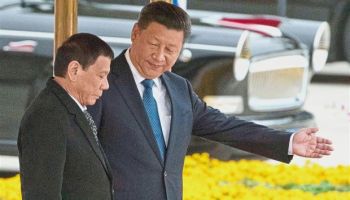https://youtu.be/aJvvvJBzp8U
China, Spain sign 10 deals worth US$17.6 bln
Chinese President Xi Jinping (L) meets with Spanish Prime Minister Pedro Sanchez in Madrid, Spain, Nov. 28, 2018. (Xinhua/Xie Huanchi)
Chinese and Spanish enterprises have signed ten deals worth 17.6 billion U.S. dollars during President Xi Jinping's visit to Spain from November 27 to 29.
These deals cover the areas of finance, telecommunication, environment, machine, vehicle and medicine, hitting a new record of China-Spain trade and economic cooperation, said the spokesperson of China's Ministry of Commerce (MOFCOM).
China and Spain also inked intergovernmental cooperation documents such as a Memorandum of Understanding in the Third Party Market, Avoidance of Double Taxation and the Prevention of Fiscal Evasion and Inspection and Quarantine of Imported Pork Products and so on.
During the visit, China-Spain Business Advisory Council was formally established and the first meeting was successfully held, becoming another platform for deepening bilateral economic and trade relations.
Xi's visit coincides with the 45th anniversary of the establishment of diplomatic ties between the two countries, and the two sides have enjoyed excellent trade relations through all these years.
China is Spain's sixth largest trading partner in the world and the largest trading partner outside the EU. From January to September 2018, the bilateral trade volume hit 25.35 billion U.S. dollars, according to the MOFCOM.
China, Spain pledge stronger BRI ties against protectionism, unilateralism
China and Spain are cooperating in the Belt and Road initiative (BRI), yielding positive outcomes, and will continue to leverage the platform to oppose protectionism and unilateralism, Chinese experts said.
The comments came after a joint statement between the two countries during Chinese President Xi Jinping's three-day visit to Spain.
Zhao Junjie, a research fellow at the Chinese Academy of Social Sciences' Institute of European Studies, told the Global Times on Thursday that Spain has seen opportunities in cooperating with China on BRI.
"Although Spain faces pressure from conservatives who oppose free trade, the two countries' cooperation on BRI will not be interrupted," Zhao said, citing the freight train between China's small commodity hub of Yiwu and Madrid as a typical BRI achievement and an important bridge across Eurasia.
"Trains were not fully loaded when the line was first launched in 2014, but fully-loaded trains now depart every day from China," the research fellow said, while stressing that Spain has a privileged position on the route.
Boosted by the route, Yiwu's imports from Spain surged 8.82 percent year-on-year to 60 million yuan ($8.6 million) in the first 10 months.
China is Spain's largest trading partner outside the EU, while Spain is the sixth-largest trading partner within the bloc for China. Bilateral trade reached $22.37 billion in the first eight months, up 10.6 percent year-on-year, according to the Chinese Ministry of Foreign Affairs.
Ding Chun, director of the Center for European Studies at Fudan University in Shanghai, told the Global Times that among EU members, Spain has shown stronger support for the BRI.
Both sides believe the Belt and Road initiative, as a platform of connectivity, will strengthen economic, trade and investment cooperation in third-party markets.
The two countries also stand ready to build synergy between BRI and related EU strategies, thus offering more mutually beneficial business and investment opportunities to Chinese and Spanish enterprises.
"On Spain's side, such cooperation in the third-party markets such as Africa will alleviate its refugee problem. It would also spark less geopolitical concerns than China-led projects in Europe," Ding said.
China and Spain can cooperate on clean energy, including wind and tide energy, Zhao said, noting that cultural exchanges should also be strengthened through education, tourism and sports.
"Cooperation with Spain's small and medium enterprises should be given greater consideration," Zhao noted.
"There are historical and geographic bases for China and Spain to conduct cooperation on the BRI," Xi said during a meeting with Spanish Prime Minister Pedro Sanchez on Wednesday, the Xinhua News Agency reported.
Sources: Global Times



























